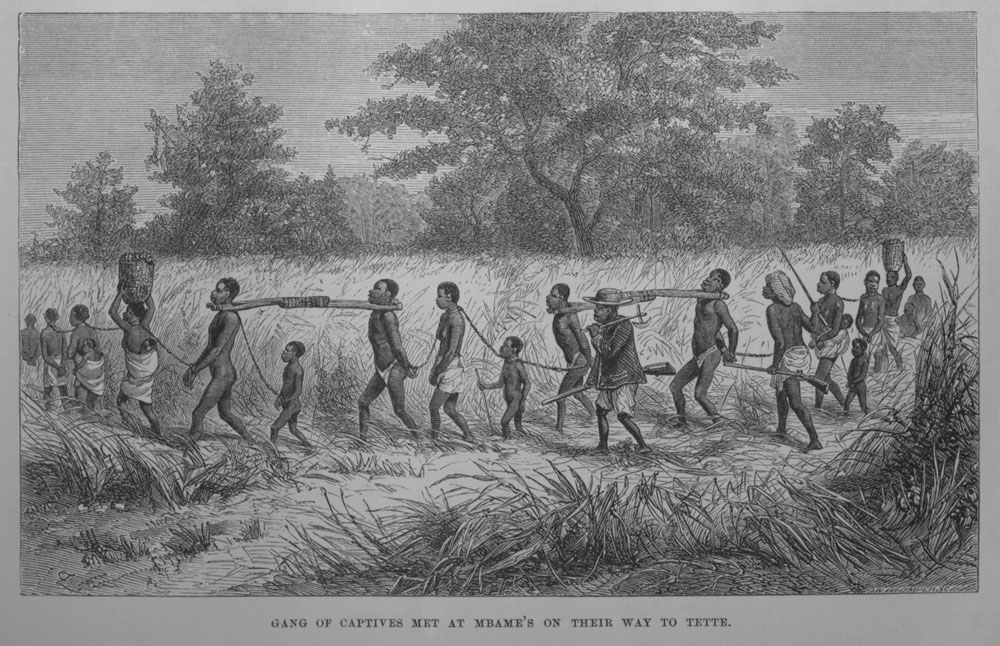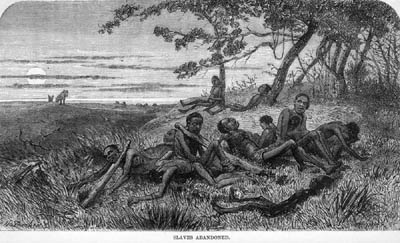2013 marks the bicentennial of Scottish explorer David Livingstone (1813-1873). His explorations in central Africa are well known – – “Dr. Livingstone, I presume.” Less well known is his first-hand encounter with the horrors of the Arab slave trade in East Africa. Two Smithsonian Libraries – – the Warren M. Robbins Library at the National Museum of African Art and the Joseph F. Cullman 3rd Library at the National Museum of Natural History – – have exceptional collections on David Livingstone and 19th-century African exploration. Drawing upon our Smithsonian Libraries’ resources, volunteer Judith Schaefer recounts David Livingstone and the other slave trade.
Part I. Initiation to Slavery
No one can understand the effect of the unutterable meanness of the slave-system on the minds of those who, but for the strange obliquity which prevents them from feeling the degradation of not being gentlemen enough to pay for services rendered, would be equal in virtue to ourselves. Fraud becomes as natural to them as ‘paying one’s way’ is to the rest of mankind. [1]
Thus did David Livingstone realize early on that slavery ruined not only the lives of the enslaved but also the character of the men who owned and traded them. This fearless, independent, strong-willed Lowland Scot, a medical missionary by training, believer in hard work and the doctrine of “Self-Help,” first encountered the reality of slavery in southern Africa, in the region known now as Botswana.
In 1847, he and his wife established a mission there among the Bakwena people, where he made his only convert— Sechele, the king of the Bakwena. This extraordinary man, who quickly learned to read and write, eventually spread Christianity more effectively than the dour Scotsman ever did, for Livingston’s religious zeal was soon combined with another cause.

The immediate problem was the Boers. Historically, these Dutch settlers had not only imported slaves from Madagascar but also seized local Africans, mostly women and children, to serve as domestic servants and farm workers. Some years earlier, Boer farmers had emigrated from the British Cape Colony into Sechele’s kingdom, their unfortunate customs still in force. In 1852, they raided Kolobeng, the village where the Livingstones lived. “The Boers plundered my house,” he wrote to a friend, “and carried off upwards of two hundred children after killing many of the adults . . . I felt it to be my duty to expose the slave-making deeds of the Boers in a letter to government.”[3] So began his passionate crusade against “the curse of Africa.”
That same year, Livingstone set out to explore the vast Zambezi River basin.[4] He first traveled west, through Portuguese Angola to the coast. Even though the infamous Atlantic slave trade had been abolished in 1803 and 1837, the demand for slaves persisted, mainly in Brazil, and Portuguese slavers were encountered along the way, driving their wretched booty to market, made a lasting impression.

The trans-Atlantic trade was, of course, not news to Livingstone, but what he saw next, following the Zambezi River back downstream all the way to the Indian Ocean and the Portuguese colony on the coast, was an unhappy surprise. Africans in the interior were trading slaves to the Portuguese, who sold them to Swahili and Arab traders in Mozambique, who in turn sent them to markets throughout the Arab world.
It was easy money, inducing Africans to ignore the natural wealth around them, such as deposits of coal, iron ore, copper, all evident to a European eye.


In talking with my companions over these matters, the idea was suggested that, if the slave-market were supplied with articles of European manufacture by legitimate commerce, the trade in slaves would become impossible. It seemed more feasible to give the goods, for which the people now part with their servants, in exchange for ivory and other products of the country, and thus prevent the trade at the beginning, than to try to put a stop to it at any of the subsequent steps. This could only be effected by establishing a highway from the coast into the centre of the country.[7]
Development of infrastructure to stimulate trade is, to this day, a concern throughout the continent.
The slave trade didn’t require roads. Slaves transported themselves to market along age-old foot trails, and if many died along the way, so what? But for legitimate trade—in mineral wealth, agricultural products, and, unfortunately, ivory—roads and means of transport were needed. What helped create wealth in industrialized Britain would surely work here, too. “One can easily detect the ‘hidden hand’ of Adam Smith and the Scottish Enlightenment in . . . Livingstone’s economic philosophy.”[8]
Critics might argue that this would still be a form of exploitation of Africa by Europe. But it was a more civilized way of exploiting people than destroying or taking its strong men and women across the seas to slavery. . . . The core of Livingstone’s point of view was the relevance of economic arguments to moral issues.[9]
Stay tuned for Part 2 in this series!
[1] David Livingstone, Missionary Travels and Researches in South Africa (London: John Murray, 1857).
[2] Carte de visite of David Livingstone. Russell E. Train Africana Collection, Smithsonian Libraries. http://www.sil.si.edu/imagegalaxy/imagegalaxy_imageDetail.cfm?id_image=10944
[3] Maurice Boucher, ed., Livingstone Letters, 1843-1872: David Livingstone correspondence in the Brenthurst Library. (Johannesburg [Houghton] South Africa: The Brenthurst Press, 1985), 69.
[4] Refer to http://myreadingmapped.blogspot.com/2013/02/livingstones-trans-african-expedition.html for an interactive Google Map of the expedition.
[5] Boucher, Livingstone Letters, 209.
[6] Ibid., image reference: knox 02. Quotation from Horace Waller, ed., David Livingstone, The Last Journals of David Livingstone, in Central Africa, from 1865 to his death (London: John Murray, 1874).
[7] Livingstone, Missionary Travels and Researches.

8 Comments
Thank you for listing MyReadingMapped’s Google Map of Dr. Livingstone’s Trans-African Expedition as citation number 4. By doing so you helped to give my site credibility. I suspect that in Part 2 of your series you will want to add MyReadingMapped’s Google Map of Dr. Livingstone’s Source of the Nile Expedition which is as you will see is a very complicated route and is integrated with, and linked to, MyReadingMapped’s Google Map of Stanley Finds Dr. Livingstone to show where each was at various times in their adventure and how they finally came together. Also, each of these maps is based on an eBook written by each explorer and can be read while viewing the map which cites each location by page number and a quote from the eBook which can be obtained by a link on my website. In addition each map also has a Google Earth KML file that enables you to digitally walk the map from location marker to location marker.
Update: the Dr. Livingstone Source of the Nile map referred to in this article has been moved to a new web site that has the ability to render the map in 3D online and has the staff and know how to keep it functional. All 160 MyReadingMapped maps are now located in the educational section of http://climateviewer.org/.
i didnt like him
It is not without a sickening feeling in my stomach, that I read anything about slavery. I certainly admire David Livingstone’s courage to take up this noble fight against the slave traders, as well as the Boers.
Thank you for this short, but very informative article. I am at this moment reading his Correspondence of 1841-1856 to LMS. What a brave Scott he was! I would, however, like to see the names of the 124 children, that the Boers had taken from Sechele. Can you assist me with that? Thanks again.
It is actually sickening, to say the least.
Savages, they were, yes. But humans, with souls; the breath of God.
Inadequate civilization may have hidden it from the Boers. It is sickening
It is sickening to know one descended from Boers that could no repent it
It is sickening that some Boer descendants still think like their forefathers
It is LESS sickening when some Boer descendants send AID to Africa
To descendants of them who were wasted in Slave Trade
Descendant who missed the skills carried with them that were wasted
Descendant who did not know where to start from. It is less sickening
Congratulations fot this post, Sir.
I have a doubt about it: are you sure Dr. Livingston wrote that “Africans in the interior were trading slaves to the Portuguese, who sold them to Swahili and Arab traders in Mozambique, who in turn sent them to markets throughout the Arab world”?
This is because at that time the arab-swahilis dominated those regions in Congo, namely Mr. “Tippo-Tip” in the nordeast and Mr. Msiri in the southeast, and Portugueses and muslims had allways been at war through History…
Can you please point the source of your statement?
Thank you very much,
Go granddad go!
[…] var på ingen måde unikke. Missionæren og opdagelsesrejsende, David Livingstone, kunne fortælle om lignende episoder på landjorden. Det er makabre historier, der ikke bør gengives her, men kun understregede den totale mangel på […]